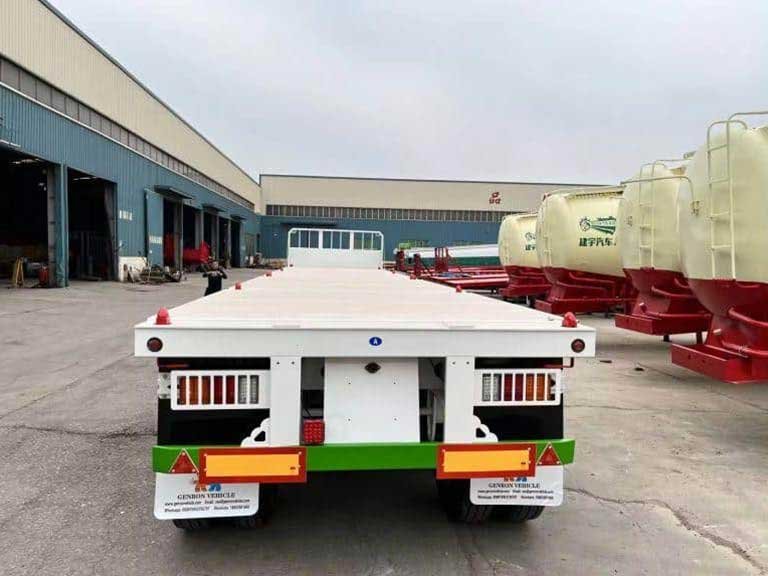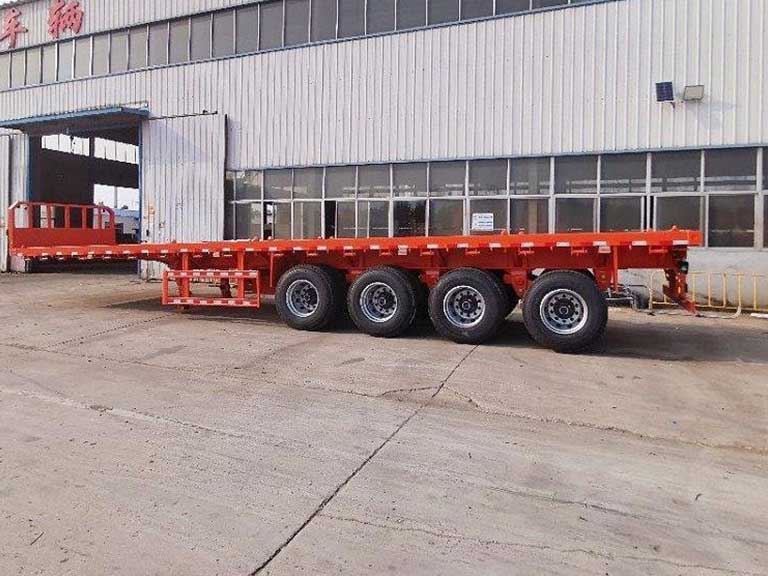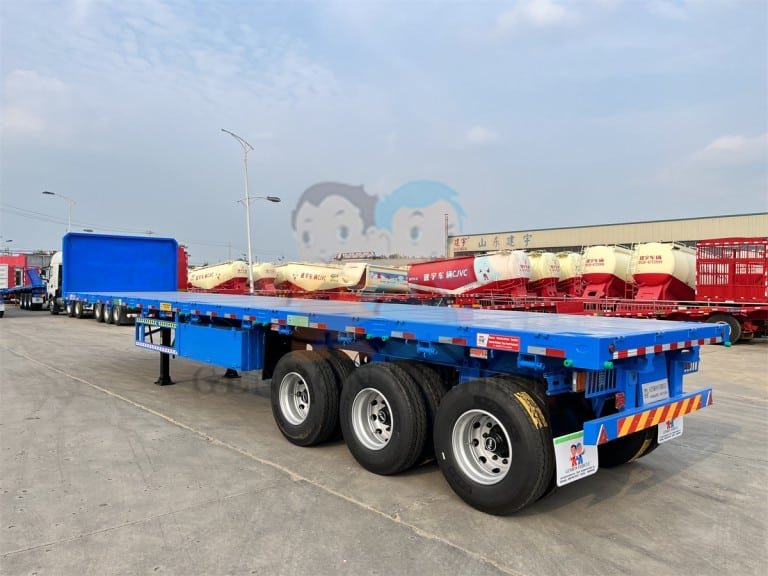The most important part of the flatbed trailer transportation process is the loading and unloading process. Flatbed trailers have an open design. Because of this design, the method of loading and fixing the goods is especially important for transportation safety. How to safely and reasonably fix the goods is something that every cargo owner needs to care about.
Transporting goods using flatbed trailers requires careful planning and professional technical knowledge. In addition, safety procedures must be strictly followed. Whether you’re hauling heavy equipment or bulk materials, improper loading can result in accidents and damage.
Table of Contents
What Is a Flatbed Trailer?
A flatbed trailer is essentially an open platform with no sides or roof. It is typically used to transport oversized, oddly shaped, or heavy cargo that cannot fit into a closed trailer. Its flat, open design allows for loading and unloading from all sides and from the top. As a result, it offers maximum flexibility when moving cargo using forklifts, cranes, or other loading equipment.
At Genron International Trade, we specialize in manufacturing high-quality flatbed trailers. Our flatbed trailers are designed to provide versatile and efficient transportation solutions.
Types of Flatbed Trailers
There are several types of flatbed trailers, each designed to cater to specific transportation needs. These include:
Standard Flatbeds: Standard flatbeds typically measure 48-53 feet in length with a width of 8.5 feet. They offering a versatile platform for various cargo types while maintaining legal road dimensions.
Step Deck (Drop Deck) Trailers: The deck height of a step trailer is lower, allowing it to load taller cargo while complying with height restrictions. Therefore, it is ideal for machinery and equipment that exceeds standard height restrictions.
Extendable Flatbeds: Extendable flatbed trailers can be adjusted in length to accommodate extra-long items, providing flexibility for transporting oversized cargo. Examples include steel beams, timber, or wind turbine blades.
Removable Gooseneck (RGN) Trailers: The removable gooseneck trailer has a detachable front section. It can form a ramp, making it easy to load heavy equipment. This is particularly useful for construction and heavy machinery transportation.
| Type of Flatbed Trailer | Description | Ideal Use |
| Standard Flatbeds | 48-53 feet in length, 8.5 feet in width | Various cargo types |
| Step Deck Trailers | Lower deck height | Taller cargo, machinery |
| Extendable Flatbeds | Adjustable length | Oversized cargo |
| RGN Trailers | Detachable front section | Heavy equipment, construction |
Begin with a bespoke semi-trailer designed for your exact needs. Whether it’s heavy-duty hauling or specialized cargo, we’ve got the perfect solution to keep you moving forward.
Legal Requirements for Transporting Loads on Flatbed Trailers
To operate a flatbed trailer legally and safely, one must be familiar with the regulations governing load transportation. The trucking industry is subject to various rules and regulations that ensure safe and compliant transportation of goods.
Weight Limits and Regulations: The maximum gross vehicle weight (GVW) for commercial motor vehicles is 80,000 pounds, including the truck, trailer, and cargo. For a typical five-axle flatbed trailer combination, the maximum load weight is between 46,000 and 48,000 pounds. Weight distribution is critical, with specific limits on steer axles (up to 12,000 pounds) and drive and trailer axles (up to 34,000 pounds each).
Dimension Restrictions: Standard flatbed loads are generally limited to 8.5 feet in width, 8.5 feet in height, and 48-53 feet in length. Of course, size restrictions vary depending on the region. Loads exceeding these dimensions are considered oversized.
Permits for Oversized and Overweight Loads: Goods exceeding standard size or weight restrictions require special permits for the areas they will be traveling through. Oversized goods exceeding 12 feet in width may require an escort vehicle and will be subject to transportation restrictions.

Preparing Your Flatbed Trailer for Loading
The preparation work for loading flatbed trailers is a key step in ensuring the safe and efficient transportation of goods. We emphasize the importance of a thorough preparation process to guarantee the integrity of both the trailer and the cargo.
Trailer Inspection Checklist
A thorough pre-loading inspection of your flatbed trailer is essential to ensure safety and prevent mechanical failures during transport. This includes checking for structural damage, worn components, and proper functionality of all systems.
- Inspect the trailer bed for cleanliness, ensuring it’s free from debris, oil, or other substances that could compromise load stability or damage sensitive cargo during transport.
- Inspect all trailer components, including the frame, cross members, deck boards, and connection points. Check for any signs of weakness, cracks, or excessive wear that could compromise structural integrity under load.
- Before beginning loading, confirm that all vehicle lights, mirrors, and safety markings are functioning properly. In addition, local Department of Transportation (DOT) requirements must be met.
Gathering Necessary Equipment and Securement Devices
Gathering the right equipment is vital for securing your cargo. We recommend having heavy-duty straps, chains, binders, and tarps that meet industry standards and are rated for the cargo weight and type.
- Gather appropriate cargo securement devices based on your specific load requirements.
- Ensure that all fixed equipment complies with Federal Motor Carrier Safety Administration (FMCSA) standards and is in good condition.
- Prepare suitable padding, such as wooden blocks, rubber mats, or non-slip materials. These will prevent cargo from moving and protect the trailer deck and cargo from damage.

How to Properly Transport a Load on a Flatbed Trailer
To transport a load on a flatbed trailer effectively, it’s crucial to understand the principles of load placement and weight distribution. We will guide you through the process, ensuring that your cargo is transported safely and efficiently.
Planning the Load Placement
Effective load planning begins with understanding your cargo’s characteristics. These include weight, dimensions, center of gravity, and any special handling requirements. We consider these factors to determine the optimal placement of items on the trailer.
- Understand your cargo’s characteristics to plan the load effectively.
- Position the heaviest items over the trailer’s axles to maintain stability.
Weight Distribution Techniques
Proper weight distribution is critical to maintaining trailer stability and preventing damage. We distribute approximately 60% of the total weight in the front half of the trailer and ensure that the heaviest items are placed near the middle.
- Distribute weight evenly to prevent overloading one axle.
- Maintain a low center of gravity by placing heavier items on the bottom.
Loading Process Step-by-Step
The loading process involves strategic planning and careful execution. We use proper lifting equipment rated for the cargo weight and ensure that personnel are trained in safe loading procedures.
- Use proper lifting equipment and trained personnel for safe loading.
- Allow adequate clearance between tall items and overhead obstacles.

Securing Your Cargo Safely
Effective cargo securement is the key to safe and successful transportation on flatbed trailers. We understand the importance of properly securing cargo to prevent accidents and ensure compliance with regulations.
Choosing the Right Tie-Down Equipment: Selecting the appropriate tie-down equipment is crucial for safe cargo transportation. We recommend using chains for heavy machinery and metal products. Web straps are more suitable for delicate items. The type of cargo and its characteristics should guide your choice of securement devices.
Cargo Securement Requirements: A minimum of one tie-down is required for every 10 feet of cargo. The combined working load limit (WLL) of all securement devices being at least 50% of the cargo’s total weight. Ensuring compliance with these regulations is vital for safe and legal transportation.
Securing Different Types of Cargo: Different types of cargo require unique securement strategies. For heavy equipment, using designated tie-down points and appropriate securement devices is essential. Edge protectors should be used to prevent damage to both the cargo and the securement devices. Implementing blocking and bracing techniques further enhances cargo stability during transit.
We should follow these guidelines and use appropriate equipment. This will ensure that goods are transported safely and reliably. Proper securing of goods can prevent accidents. In addition, it can protect goods from damage and ensure smooth transportation.

Safety Considerations During Transport
When transporting cargo on flatbed trailers, safety should be the top priority to avoid potential hazards. We emphasize the importance of careful planning and execution to ensure safe transportation.
Regular Cargo Inspections During Transit: Regular cargo inspections are vital during transit to ensure that the cargo remains secure. It’s a good practice for drivers to conduct quick inspections every 50 miles to verify that the cargo hasn’t shifted and that tie-downs are still holding. Repeat inspections every 150 miles or 3 hours of driving.
Driving Techniques for Loaded Flatbeds: Adjusting driving techniques is crucial when operating a loaded flatbed trailer. Drivers should take turns more slowly and maintain greater following distances to account for the higher center of gravity.
Weather Considerations and Tarping: Monitoring weather conditions is essential throughout the journey. High winds can affect tall loads, and adverse weather conditions like rain, snow, or ice can impact both traction and cargo securement.
By following these safety precautions, drivers can significantly reduce the risk of accidents. And ensure the safe transport of flatbed trailer cargo

How To Unload A Flatbed Trailer?
When unloading a flatbed trailer, it is important to follow safety steps. This is because it can effectively prevent cargo movement or accidents. The following are key unloading safety measures:
Avoid Unloading on Slopes: This is because if you unload on a slope, it can easily cause the cargo to tilt or roll over. Apart from this, you should also check for mounds or depressions. Avoid all kinds of instabilities that can lead to serious rollover accidents.
Make Sure There is Enough Space: It is a must to reserve enough space for unloading. You can choose the right area for unloading according to the actual situation.
Start from the Back: When loading, start from the left and right sides. And when unloading, operate from the back, alternating between left and right. When unloading in a weak country, there is no front towing device, so it is necessary to add support points at the front of the trailer.
Use a Safety Ladder or Trailer Ladder: Using a safety ladder or trailer ladder is a safer way to unload. This allows you to unload without having to climb on the tires or other parts of the trailer. Also, with this component, you can unload your cargo faster. However, not all trailers have this accessory. This is because different types of flatbed trailers have different transportation purposes, and the corresponding functions are not exactly the same.
Use a Forklift to Unload Heavy Cargo: For heavier items, you can use a forklift or other mechanical equipment. This avoids contact between people while ensuring a safe unloading process.

Conclusion
At Genron International Trade, we understand the complexities of flatbed trailer transportation. Our experience in manufacturing trailers for diverse markets has given us unique insights into the requirements for safe and efficient flatbed shipping.
To ensure cargo reaches its destination safely, it’s crucial to select the right flatbed trailer design and follow proper loading and securement procedures. This includes understanding legal requirements, maintaining equipment, and adapting to weather conditions.
By choosing the right equipment and techniques, you can ensure a successful transportation process.
FAQ
What are the weight limits for flatbed trailers?
Weight limits for flatbed trailers vary depending on the trailer’s configuration, axle count, and local regulations. Typically, a standard flatbed trailer has a gross vehicle weight rating (GVWR) ranging from 48,000 to 80,000 pounds. It’s essential to check the manufacturer’s specifications and comply with federal and state regulations.
How do I properly secure cargo on a flatbed trailer?
To secure cargo on a flatbed trailer, use suitable tie-down equipment, such as chains, straps, or ropes, that meet the Federal Motor Carrier Safety Administration (FMCSA) cargo securement requirements. Ensure the cargo is evenly distributed and the tie-downs are properly tightened to prevent shifting during transit.
What are the dimension restrictions for flatbed trailers?
Dimension restrictions for flatbed trailers vary by state and locality. Generally, the maximum width is 8.5 feet, and the maximum height is 13.5 to 14 feet, depending on the jurisdiction. Length restrictions also apply, typically ranging from 48 to 53 feet for a standard trailer. Oversized loads require special permits and may need escort vehicles.
What type of equipment is needed for loading and unloading heavy equipment on a flatbed trailer?
For loading and unloading heavy equipment on a flatbed trailer, you’ll need equipment like forklifts, cranes, or winches, depending on the size and weight of the cargo. Ensure the equipment is rated for the weight and is properly secured to prevent accidents.
How often should I inspect my flatbed trailer and cargo during transit?
Regular inspections are crucial to ensure safe transportation. Check the trailer and cargo at the beginning of the trip, after the first 50 miles, and then at regular intervals (e.g., every 150 miles or every 3 hours). Inspect the tie-downs, cargo, and trailer for signs of wear, damage, or shifting.
Can I transport oversized or overweight loads on a flatbed trailer?
Yes, but you’ll need to obtain special permits and comply with specific regulations. Oversized or overweight loads require additional safety measures, such as escort vehicles, warning flags, and pilot cars. Check with state authorities for permit requirements and restrictions.


